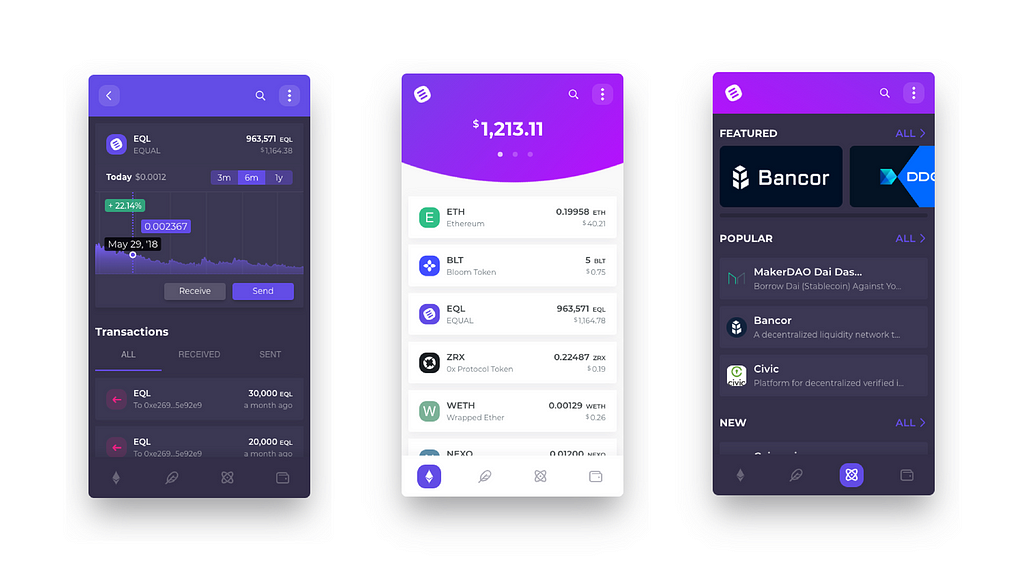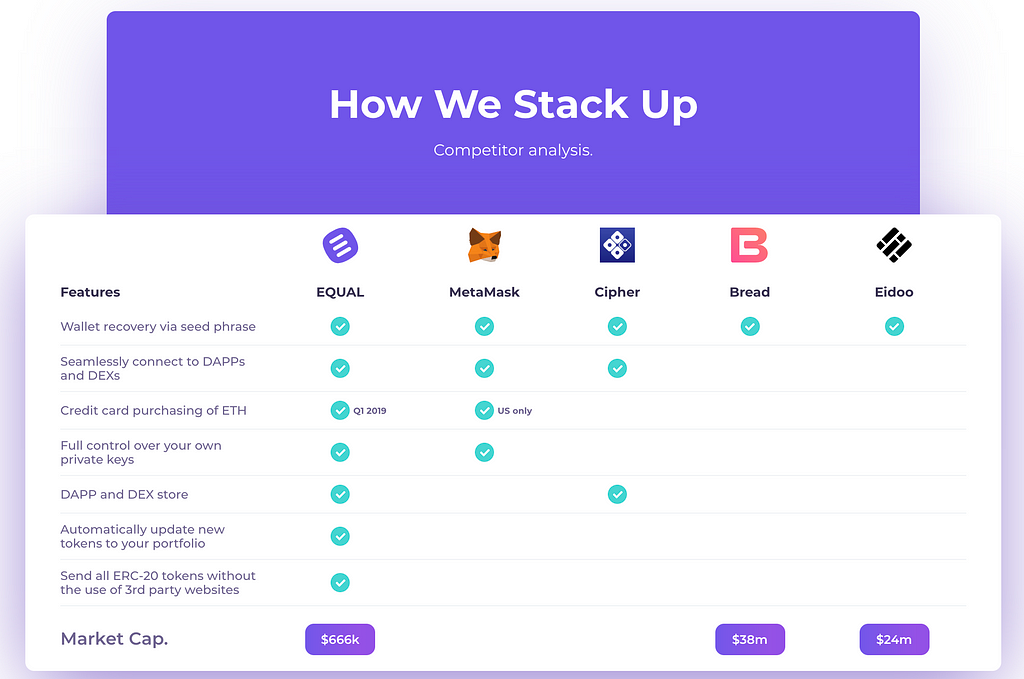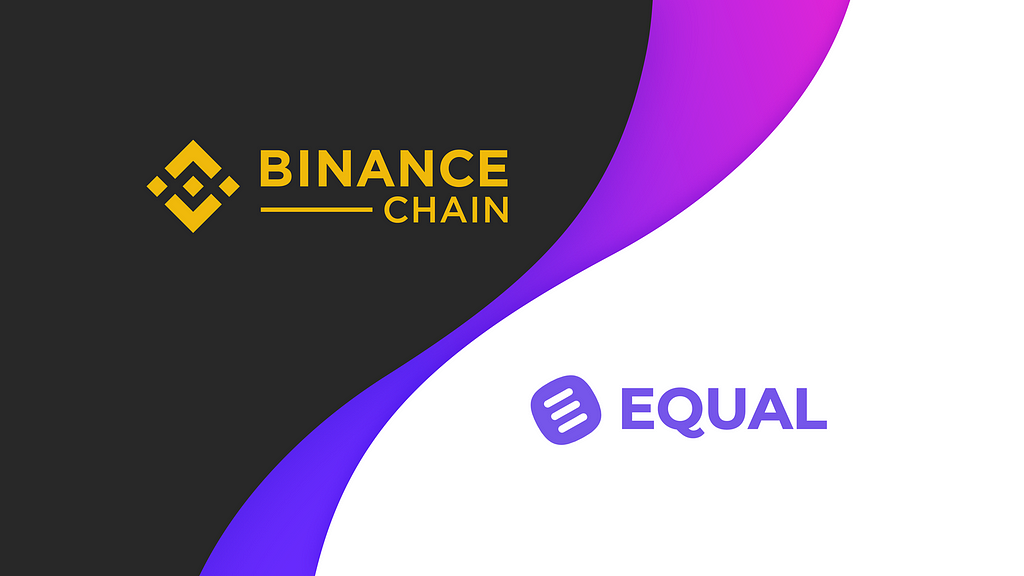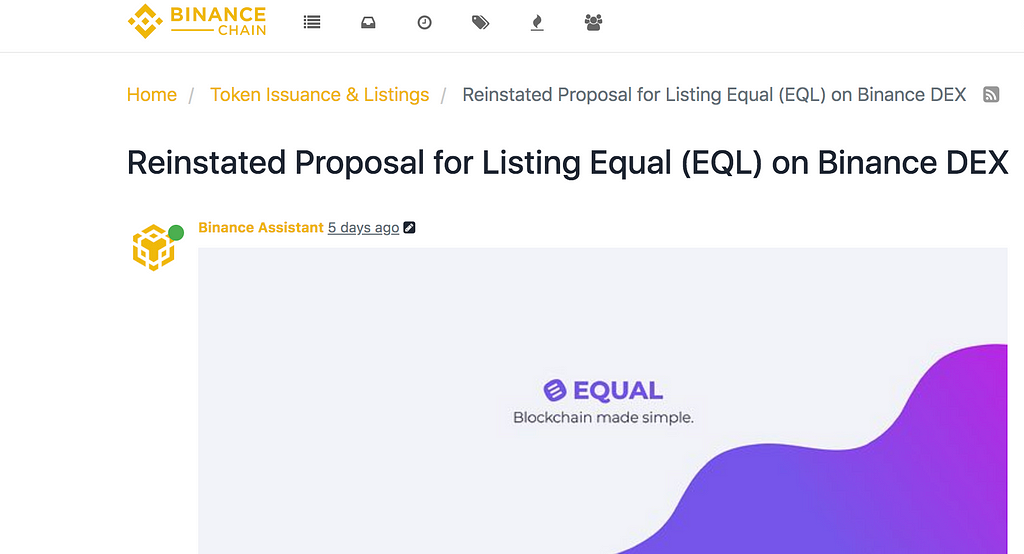Latest news about Bitcoin and all cryptocurrencies. Your daily crypto news habit.
Exploring why Binance is keen to partner with a project with a million dollar market cap.
 Screenshots of the Equal Wallet - Web extension.
Screenshots of the Equal Wallet - Web extension.
Opportunity Snapshot
This document is designed to be a birds-eye view of the Equal project, as it presents as both a ‘one-stop’ non-custodial wallet (user controlled assets) and also an exploration of the value and network design of the EQL token.
As an overriding thought, the project ethos is “blockchain made simple” as it aims to remove the barriers to entry and soften the learning curve for new crypto users.
It is also worth noting that Equal did not seed using an ICO, and as such has been self-funded and supported privately by those in their community.
While not ground-breaking, I think this is important when looking at the crypto space as a whole, where founders are often unwilling to support their projects with their own capital. This is a shift from the traditional start-up culture, made most famous from Silicon Valley and Shenzhen.
The Next Iteration Crypto Wallet
Equal will not only reach feature-parity with other current web-based wallet offerings such as MetaMask (over one million users) but surpass it and become the next iteration in web3 web-based wallets.
What does this mean in practice?
Intuitive UX, automatic gas-rates, no central authority and seamless interaction with the Ethereum & Binance blockchains (access to dApp marketplaces, and decentralized exchanges — “DEX’s”).
In an earlier medium post written by the project, they compare MetaMask to Netscape and the speak about the important role that it played in the development of modern browsers.
Equal as such is the next evolution of web-based wallets & to continue the metaphor would be the equivalent of Google Chrome as a direct comparison.
The Token
The reason the project is called ‘Equal’ is to do with the central ethos of the token, and by extension the method of how it was minted.
The EQL token was initially airdropped for in December 2017!
One reason for this beyond the obvious fact that they did not ICO was to create an equal distribution of currency and avoid the pitfalls that other projects have experienced of having “whales” effectively control the token price and in some cases decision making of the project by gaining heavily discounted prices for investors that had early access to private rounds.
Airdropping the token was a way that the project would be judged on its merits; ie the quality of the development rather than how much was raised.
Most importantly though they didn’t need to do it, so they didn't!
But egalitarianism aside, the tactic had some incredible community building advantages.
For starters, it was fully subscribed by the capped number of 5000 participants.
This means that overnight they had an engaged community that was energized to interact with beta versions of the wallet and of course, promote the awareness of the project.
Token Development
The EQL token was originally built on Ethereum and is in the process of being migrated to the Binance Chain and BEP2-standard.
The migration process will occur in the Equal Wallet, displaying Equal Wallet’s unique chain migration capabilities to all current and future token holders. The Equal Wallet will integrate Binance Coin and the subsequent Binance Chain. This will allow for users to hold the new EQL token in BEP-2 format in the Equal Wallet.
While this is a monumental achievement for the project it does have one obvious downside from my point of view, and that is to do with token design that was not able to be reproduced on the Binance chain.
In the original vision of the token on Ethereum, it had a deflationary burn fee.
In a nutshell, as the token was used a small amount of EQL (250) as a condition of the smart contract. Instead of this fee going back to the network it was ‘burnt’, or in other words destroyed completely.
From an economic POV this steadily decreased the total supply and in turn users and investors would experience predictable growth as their share of tokens relative to available supply increases.
TL;DR: If the supply of the token goes down, then the value of existing tokens goes up — this design proposes a positive feedback loop (not dissimilar in construct to what SN proposed and implemented with Bitcoin).
I thought this was a really elegant design mechanism!
But alas, it required adjustable smart contracts to execute and Binance doesn’t use smart contracts.
Shame, but a small price to pay all things considered.
So what does it do?
- Become the official payment mechanism for all Equal products and services
- Provide fee reduction on Swapping Exchange.
- Used to unlock premium features within the wallet
- Used by DAPP Developers to market on the Equal DAPP Store
- Access to Equal Pro Version
The Importance of DEXs & Partnership with Binance DEX.
Centralized exchanges hold undue power over users. The current mechanics allow them to engage in many of the regressive practices that cryptocurrency fundamentally opposes in the fiat world; primarily in the form of unilateral fee structures and vulnerable security practices relating to data and the assets themselves.
What use are “decentralized currencies” if we are still hamstrung by centralized exchange?
Crypto as a whole has essentially replaced the ‘nation-state’ with an ‘exchange-state’, that is, the exchanges have become the ruling central authorities.
This is counter-intuitive to the ethos and driving force of the crypto movement.
In the same way that Craig Wright, in his quest of no-consequence, to prove he is ‘Satoshi’ attempts to copyright the Bitcoin whitepaper — and in effect does the exact opposite by fundamentally not understanding the core issues at play with Bitcoin.
While of course, his claims hold no water anywhere, trading decentralized currencies on centralized exchanges is equally naive as the space aims to complete the circle of non-custodial principles it aspires to.
Put simply, we need to build that useful decentralized currencies, that are traded without central overview. This will allow for freer markets, that are less prone to manipulation and corrupt & malicious practice from traders and exchanges alike.
As Anthony Pompliano said recently on Twitter;
“Bitcoin was the first major step towards the separation of state & money.”
 Decentralized Exchange — the removal of central authority.
Decentralized Exchange — the removal of central authority.
Decentralized Exchanges (DEXs) are the necessary solution, as a decentralized alternative will allow users to control the ownership of their assets.
Given all this, it should be curious or at the very least interesting that the most dominant centralized exchange Binance, is placing considerable efforts and resources into creating its own decentralized exchange, the suitably titled Binance DEX.
A few things about the Binance DEX….. it isn’t perfect by any means, but it is incredibly encouraging that the party with the most to lose by decentralised exchange (as the dominant central exchange by volume) is actively developing its own DEX.
A few things about the Binance DEX
- The Validators are all controlled by the exchange, this on the surface is not a good look in terms of true ‘separations of powers’ between exchange and protocol. However, again at surface level, it does appear to have some performance benefits.
- The validators are incredibly thorough, and the process of approval/disapproval of listing is transparent and public.
- So while the exchange will never be ‘true DEX’ — IT WILL facilitate the non-custodial exchange of assets (limited to BEP2 tokens at this stage), run on a fast blockchain and be easy to use.
- It would be naive to think that Binance would actively try to give up all of the power it has built up, but the fact that the exchange recognizes the need to champion this technology is tantamount to the values of the crypto community.
Listing Process on Binance Dex
All listing proposals for the Dex must be posted to the public forum for the Binance community to openly discuss and critique.
The validators look at these proposals, probe the applying projects with critical questions to assess their validity.
If the validators are satisfied they vote on whether the project is worth listing on Binance Dex.
The Equal project was obviously successful with this process, and you can see the detailed submission archived here:
https://community.binance.org/topic/76/reinstated-proposal-for-listing-equal-eql-on-binance-dex
Summary
To bring this story back to EQL, this relationship is undoubtedly a good thing. As one of the first projects to migrate to the BEP2 standard and by extension the Binance DEX, Equal will be working closely with the biggest company in the crypto space to further enhance the decentralized landscape.
This makes a lot of sense when you consider the community-driven values of the project and the mission statement of lowering the barriers of entry for new crypto adopters as a way of driving broader adoption.
To put it a different way; Equal, a small self-funded crypto project from Melbourne that minted it’s token in an air-drop to promote equal distribution is now working with the largest entity in the crypto space hand in hand to drive decentralized exchange to the masses.
Quite an achievement all things considered!
An Adoption Focused Wallet & Token for the Binance DEX was originally published in Hacker Noon on Medium, where people are continuing the conversation by highlighting and responding to this story.
Disclaimer
The views and opinions expressed in this article are solely those of the authors and do not reflect the views of Bitcoin Insider. Every investment and trading move involves risk - this is especially true for cryptocurrencies given their volatility. We strongly advise our readers to conduct their own research when making a decision.



